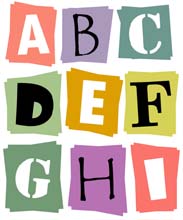Dysphonetic Dyslexia: Reading
and Spelling Patterns

The terms dyseidetic and dysphonetic are words used to describe types of dyslexia.
The prominent characteristic of dyseidetic dyslexia, also called visual dyslexia, is the inability to revisualize the gestalt of the word. Usually, the child has little difficulty spelling words which may be long but are phonetically regular. It is the small but irregular nonphonetic words, such as what, the, talk, does, that create the greatest difficulty for this child.
Dysphonetic dyslexia, on the other hand, is associated with auditory-processing difficulties. These children have difficulty remembering letter sounds, analyzing the individual sounds in words, and sequencing/blending these into words.
Author Corinne Roth Smith lists the reading and spelling patterns of children with dysphonetic dyslexia (also called auditory dyslexia):
- Difficulty discriminating between individual sounds in beginning reading instructions (occurs very seldom).
- Difficulty processing rapid auditory inputs so that consonant sounds that cannot be sustained (p-b) are not perceived; these may then be omitted in reading.
- Poor ability to analyze the sequence of sounds and syllables in words; consequently they become reversed in reading words; this is akin to the problem faced orally when poor auditory analysis has taught the child such phrases as “lead a snot into temptation” and “Harold be Thy name” in the Lord’s prayer, or “lmnop” being one lumped cluster in the alphabet song.
- Poor ability to remember individual sounds or sequences of sounds.
- Difficulty blending individual sounds into words.
- Difficulty listening to words and omitting one sound and substituting it for another (say cat; now take off the /c/ and put on an /f/); such abilities are essential for word analysis because that is what figuring out how to phonetically decode a word is all about; children usually develop this skill with initial consonants, and then medial vowels or consonants.
- Difficulty remembering the sounds that individual letters and phonetically regular and irregular letter combinations represent.
- Inability to rapidly retrieve letter sounds while analyzing words, so that the beginning of the word is forgotten by the time the last letter of the word is recalled (naming problem).
- Difficulty analyzing unknown words because of poor knowledge of phonetic rules and difficulty sequencing sounds.
- Difficulty applying the phonetic rules from words that can be read to pseudowords that follow the same pattern but are not real words.
- Vowel sounds are particularly troublesome.
- Word substitutions that are conceptually (person, human) or visually (horse, house) related, but not phonetically related.
- Limited sight vocabulary because the student cannot memorize an abundance of words without the benefit of phonetic cues.
- Guessing at unfamiliar words rather than employing word-analysis skills.
- Spelling remains below reading level because it is attempted by sight rather than by ear.
- Correct spellings occur primarily on words that the child has encountered repeatedly and therefore can revisualize.
- Bizarre spellings that seldom can be identified, even by the child, because they do not follow phonetic patterns.
- Extraneous letters and omitted syllables in spelling.
|
Edublox programs are effective in overcoming dyslexia, dysgraphia and other learning difficulties by addressing the underlying shortcomings that interfere with academic performance.
|
|